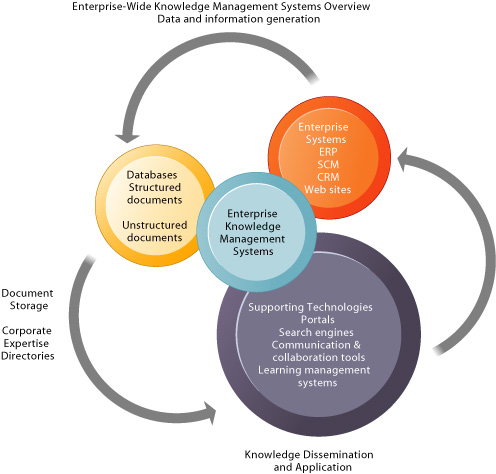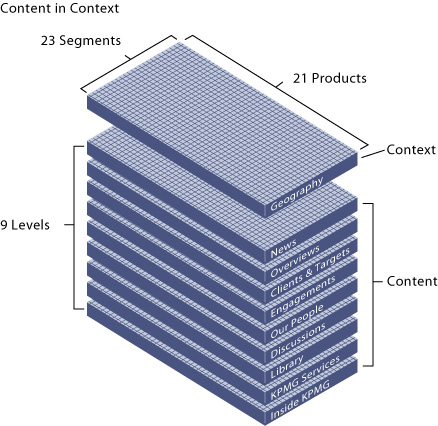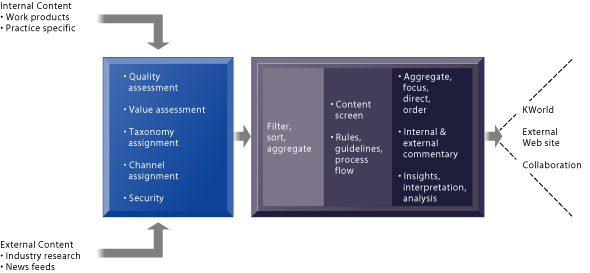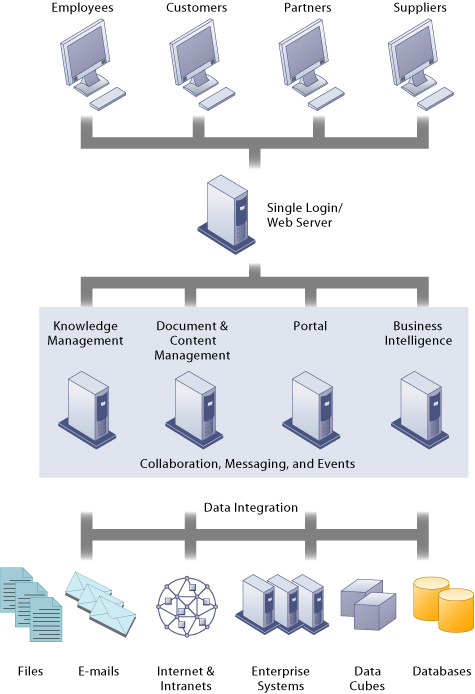| Section 12.2: Bullet Text |
Chapter
Contents | View
Full Text | View Bullet Text
|
| Enterprise-Wide Knowledge Management Systems |
Enterprise-wide knowledge management systems are firmwide
efforts to collect, store, distribute, and apply digital content and knowledge.
They use an array of technologies for storing structured and unstructured
content, locating employee expertise, searching for information, disseminating
knowledge, and using data from key corporate systems. Enterprise-wide
knowledge management systems consist of structured knowledge systems,
semistructured knowledge systems, and knowledge networks. [Figure 12-4]
 |
|
FIGURE 12-4 Enterprise-wide knowledge management systems Enterprise-wide knowledge management systems use an array of technologies for storing structured and unstructured documents, locating employee expertise, searching for information, disseminating knowledge, and using data from enterprise applications and other key corporate systems. |
Structured
knowledge systems provide databases and tools for organizing
and storing structured knowledge that exists in formal documents. KPMG
International’s KWorld is an example. It provides online access
to presentations, white papers, best practice guidelines, methodologies,
human resources information, professional resumes, research reports, and
external news sources. It also features a tool that permits collaboration
among team members and clients in a secure Web environment. [Figure 12-5,
Figure 12-6]
 |
| FIGURE 12-5 KWorld’s knowledge domains KPMG’s KWorld is organized into nine levels of content that are further classified by product, market segment, and geographic area. |
 |
| FIGURE 12-6 KPMG knowledge system processes KPMG systems classify, filter, and organize content from both internal and external sources for use internally in KWorld and externally on the company Web site. |
Semistructured
knowledge systems provide databases and tools for organizing
and storing semistructured knowledge, such as e-mail, brochures, or rich
media, that is not in a formal document or report. Such systems provide
a database and technical infrastructure tracks, stores and organizes semistructured
content. [Figure 12-7]
 |
| FIGURE 12-7 Hummingbird’s integrated knowledge management system Hummingbird’s enterprise solution combines document management, knowledge management, business intelligence, and portal technologies and can be used for managing semistructured as well as structured knowledge. |
Structured and semistructured knowledge systems provide knowledge repositories. Taxonomies and tagging are used to classify repository content so that it is easier to access.
To
disseminate tacit knowledge, knowledge systems may provide directories
and tools for locating firm employees with special expertise. Knowledge
network systems try to turn tacit, unstructured knowledge
into explicit knowledge that can be shared in a database. [Figure 12-8,
Figure 12-9]
 |
|
FIGURE 12-8 The problem of distributed knowledge In many organizations, essential knowledge is not available even though someone in the firm may have the information. The problem is finding the right person or group. |
 |
| FIGURE 12-9 AskMe Enterprise knowledge network system A knowledge network maintains a database of firm experts, as well as accepted solutions to known problems, and then facilitates the communication between employees looking for knowledge and experts who have that knowledge. Solutions created in this communication are then added to a database of solutions in the form of FAQs, best practices, or other documents. |
Enterprise-wide knowledge management systems also include group collaboration tools (groupware and teamware), portals to simplify information access, search tools, and learning management systems. Many organizations have built specialized enterprise portals to help individuals navigate through various knowledge resources. These enterprise knowledge portals direct individuals to digital knowledge objects and information system applications, helping them make sense of the volume of information that is available and also showing how organizational knowledge resources are interconnected.